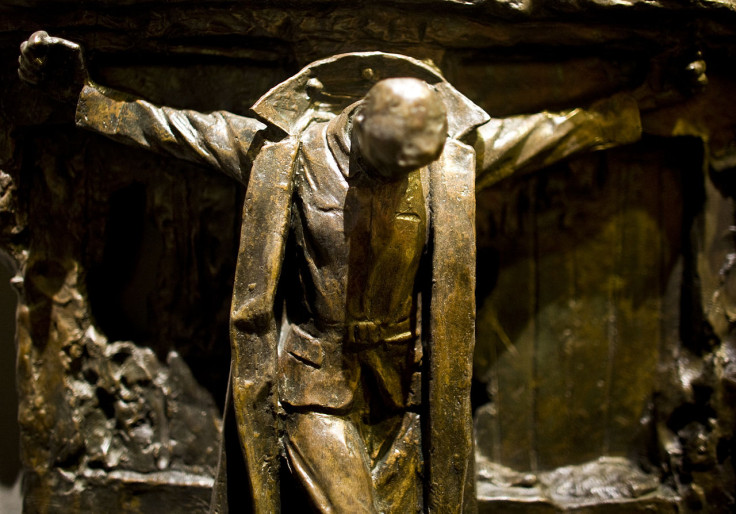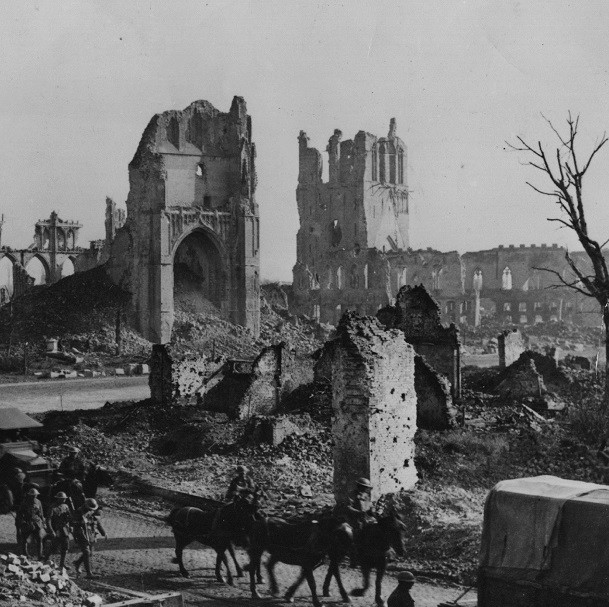Ypres anniversary: Why we must all remember the Crucified Soldier

The incident took place on 24 April 1915. Accounts might differ in the details, but it happened in or around St. Julien, by the Ypres salient, behind enemy lines.
The soldier was recorded as being white, around 5ft 10in, clean-shaven with brown hair. His nationality was Canadian, his Maple lapels hanging limply. His rank was that of a Sergeant. And he was found dead, crucified against a barn door, six bayonets pinioning his hands and his feet.
The Crucified Soldier was one of the most evocative and shocking images that emerged from the Great War in the spring of 1915, one hundred years ago today. So strong was this image that, over time, it took on its own meaning. Some reports claimed that six men were found crucified. Others that the man's eyes had been gouged out. That he was found wearing a crown of barbed-wire. That he was French or British. That he died protecting an old woman. Even investigations into the death at the time found accounts confused and contradictory.
After the war, the conflicting nature of trench gossip caused many to dismiss the story as ugly, black propaganda. The Crucified Soldier was seen as just one of many horrific myths born in the quagmire and blood of the Western Front. But in my searching for the truth of what really happened in April 1915, that cruelest of months, one thing emerged that you normally don't find in black propaganda – a name.
Sgt. Harry Band was a Canadian soldier who served in the 48<sup>th Highlanders, 15<sup>th Battalion. He was born in Scotland; 29 years old, 5ft 11in, with brown hair. Records show him missing on the 24 April, 1915. Of course, this is not enough to show that he died in agony against a barn door. But other, disparate mentions of Band's name suggest he may well have died this way.

'To soldiers brought up in rural areas, young men unaccustomed to the chemical advances of that new century, this ugly, industrial form of warfare must have been terrifying. Such men had been raised on a vision of warfare in which bayonets and honour held sway, where conflict was meant to be fair and clean. But gas was none of those things.'
Iain Overton on the impact of poison gas, first used on 22 April 1915. Read the article here.
In 1921, the Temperance Society of Toronto listed him as meeting his death 'by crucifixion while in the hands of the enemy'. Band's own sister, Elizabeth Petrie, was sent two letters from Private W. Freeman that said her brother "was crucified." And the Peter Liddle Collection in Leeds contains a statement made by a recuperating L/Cpl. C. M Brown that said: 'There was a Sgt. Bain or Band, but I cannot remember the number. He was crucified after a battle of Ypres on one of the doors of a barn with five bayonets in him.'
The words of Freeman and Brown do something that normally does not exist in most black propaganda myths. It roots a killing in a time, a place, with a name.
Others at the time clearly believed that Band died this way. A memorial of the death was even commissioned in bronze – the Derwent Scuplture showing a frieze of a soldier, arms outstretched on a barn door, hands nailed to the wood by bayonets. Beneath him a cluster of Germans sit drinking, throwing dice and mocking his agony.
Battle between good and evil
The heavy symbolism of this death of an innocent was acute. It spoke to an emerging belief that the war had become a deep struggle between the forces of good and evil; a war that, in a way, had lost all sense of honour and compassion.
A letter home by one soldier summed it up: "They [the Germans] are fighting to win anyhow regardless of all the rules of fair play, and there is evidence they do not hesitate at anything in order to gain victory."

Band's death strengthened the conviction that the war had to be won at all costs. One wrote: "The news of the crucified men soon reached all of the ranks. It increased our hatred." It deepened the Allies' loathing for the Germans and helped push the war into a battle for the heart of Europe – a struggle for the very essence of civilisation.
The use of poison gas in the trenches, the sinking of the passenger ship Lusitania, the publication of the Bryce report on Belgian atrocities, the bombing of British seaside towns, and the execution of nurse Edith Cavell all occurred within the first five months of 1915. But the report of a young man dying in such a torturous and symbolic way stuck uniquely in the troops' minds.
This is possibly because Band's death may well have been recalled with every sighting of a crucifix in Catholic France by a homesick soldier. One remembered in trench names such as 'Crucifix Corner'. A death that epitomised a surreal, violent war filled with fear and superstition, where bibles were placed over men's hearts to help stop that seemingly inevitable bullet.
At its heart, ultimately, Band's death touched many a soldier's deep, psychological fear of a terrible death.
In this way the Crucified Soldier should still speak to us a century on, to remind us that war always descends into horror, and that violence can only lead to the terrible death of innocence. And that is why, a century on, we should remember the Crucified Soldier and all that his death contains.
Iain Overton is Director of Policy at the London based charity Action on Armed Violence. His first book, Gun Baby Gun: a bloody descent into the world of the gun, was published this month.
© Copyright IBTimes 2024. All rights reserved.







